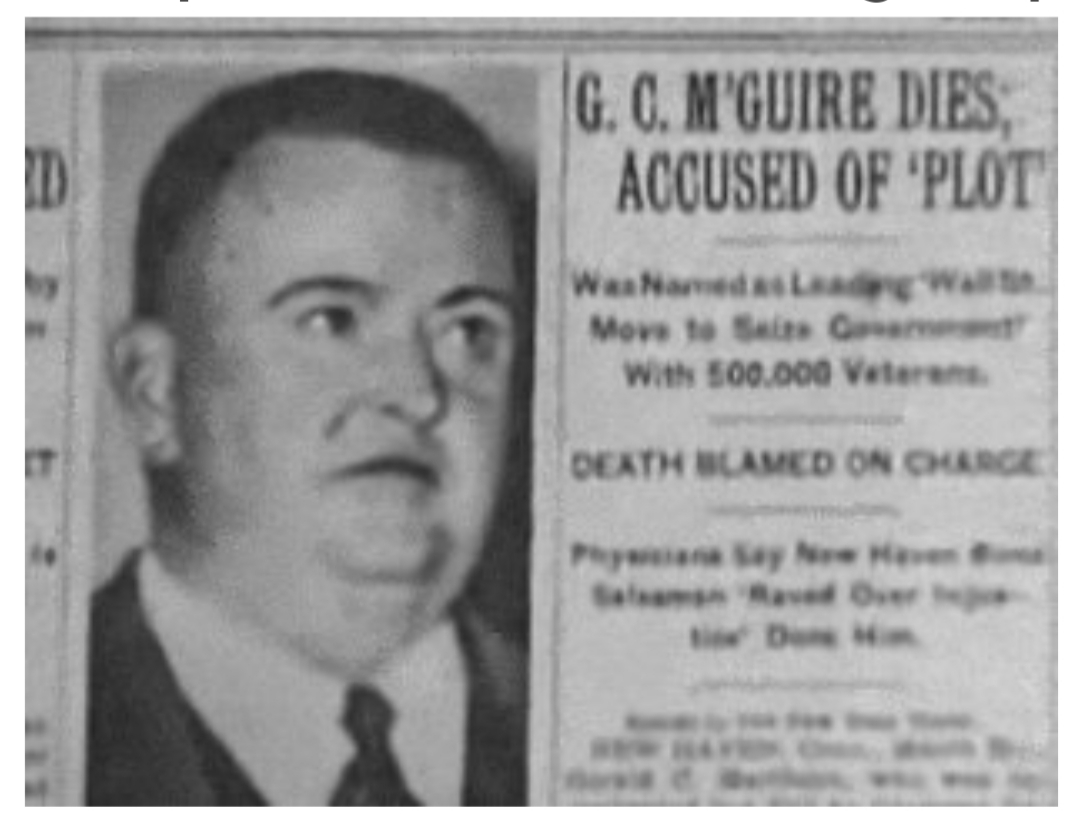Alleged coup plotter Gerald Macguire.
[The Archives]
With a dictator wanna-be in the White House and the alarming rise of fascist-like forces around the country, here’s a relevant chapter from American history that’s worth revisiting.
In 1933, retired Marine Corps General Smedley Butler was visited at his Pennsylvania home by individuals virulently opposed to newly elected President Franklin Roosevelt. Butler himself was an enthusiastic supporter of Roosevelt and he took the meetings only because the visitors had told him the purpose was to discuss upcoming American Legion elections. He was one of the best-known military men in the country and had a unique reputation for being popular with everyday soldiers. Unbeknownst to Butler, it was that reputation that brought the visitors to his doorstep.
Among the visitors was Gerald MacGuire, the Legion’s Connecticut commander. MacGuire was born in Rhode Island on May 10, 1897, served in the First World War, settled afterwards in Darien and was employed at a prominent Wall Street brokerage house. He and many of the moneyed men he worked with were alarmed at Roosevelt’s proposed policies. As the meeting progressed, Butler grew suspicious of MacGuire, especially when MacGuire said he had large sums of money at his disposal to bankroll a run by Butler for the Legion’s top post, and decided to play his visitors along in order to learn more about their plans.
In the meantime, MacGuire travelled to Italy and Germany in early 1934 to study how veterans’ groups helped the fascists come to power in those countries. When he returned, he finally told Butler the whole story: very wealthy, powerful men had made three million dollars available to him, with much more to come, to organize a coup against Roosevelt. The American Legion would be the 500,000-strong vehicle and they wanted Butler to lead it.
The plan would render Roosevelt a figurehead and accounts vary as to whether Butler or someone else would be installed as the nation’s leader. General Joseph MacArthur and Brigadier General Hugh Johnson, head of the National Recovery Administration, were also apparently under consideration. That Johnson was considered seems odd given that Roosevelt had just appointed him to head the NRA, but Johnson was an enthusiastic admirer of Italian dictator Benito Mussolini whose vision of the proposed New Deal was essentially that of a corporate, fascist state.
Besides MacGuire, Butler met with Robert Clark, an heir to the Singer Sewing Machine Company. Clark confirmed MacGuire’s proposal and named other plotters who would soon form the Liberty League: executives from the duPont Corporation including Irene du Pont; associates of J.P. Morgan including one-time Democratic Vice Presidential candidate John Davis and Thomas Lamont, great-grandfather of Connecticut’s current governor; Al Smith, the Democratic Presidential candidate in 1928 who ran with Davis; Grayson Murphy, MacGuire’s boss and a director of Goodyear Tire, Anaconda Copper and Bethlehem Steel; and other business and military figures, diplomats and politicians. Weapons and ammunition would be supplied by the Bridgeport-based, DuPont-owned Remington Arms.
Butler told of the plot to Paul Comly French, a reporter for the Philadelphia Record. When contacted by French, MacGuire spoke openly of his desire for a fascist America and steered the reporter to some of his associates. French wrote an expose that was published in both the Record and the New York Post. Butler, meanwhile, finally told MacGuire his true feelings: “If you get 500,000 soldiers advocating anything smelling of Fascism, I am going to get 500,000 more and lick the hell out of you, and we will have a real war right at home.”
Butler told what he knew to various government officials, and Congressional hearings were held in 1934, featuring Butler testifying for many hours. All of those who Butler named as being involved vehemently denied the charge, including MacGuire.
In part because of a lack of concrete evidence, no charges were brought. Roosevelt intervened to essentially suppress the transcript records of some of Butler’s most damning testimony. Several accounts speculate Roosevelt did so out of fear that an already divided nation would grow still more divided if the full story of the Business Plot, as it became known, was made public.
MacGuire died suddenly in Connecticut of pneumonia on March 25, 1935 shortly after the hearings. Catapulted to national fame, Butler became even more famous when he wrote War is a Racket a short time later. In the book, he said of his years as a military man that “I spent most of my time as a high class muscle man for Big Business … a gangster for capitalism” who “might have given Al Capone a few hints.”
Hailed by many as a hero for exposing the plot, Butler died in 1940. The story of the Business Plot has been the subject of documentaries, television programs and a BBC Radio documentary that implicated another prominent Connecticut man: Prescott Bush, a Wall Street executive living in Greenwich who later was a U.S. Senator from the Nutmeg State and whose son and grandson both served as President of the United States. Academy Award-winning director Oliver Stone announced in 2000 that he was planning to make a feature film about the Business Plot but those plans were eventually scrapped.
Bridgeport native Andy Piascik is a long-time activist and award-winning author whose most recent book is the novel In Motion. He can be reached at [email protected].








